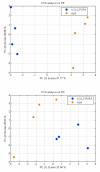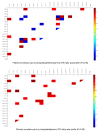Differential effect of maternal diet supplementation with alpha-Linolenic adcid or n-3 long-chain polyunsaturated fatty acids on glial cell phosphatidylethanolamine and phosphatidylserine fatty acid profile in neonate rat brains
- PMID: 20148111
- PMCID: PMC2819247
- DOI: 10.1186/1743-7075-7-2
Differential effect of maternal diet supplementation with alpha-Linolenic adcid or n-3 long-chain polyunsaturated fatty acids on glial cell phosphatidylethanolamine and phosphatidylserine fatty acid profile in neonate rat brains
Abstract
Background: Dietary long-chain polyunsaturated fatty acids (LC-PUFA) are of crucial importance for the development of neural tissues. The aim of this study was to evaluate the impact of a dietary supplementation in n-3 fatty acids in female rats during gestation and lactation on fatty acid pattern in brain glial cells phosphatidylethanolamine (PE) and phosphatidylserine (PS) in the neonates.
Methods: Sprague-Dawley rats were fed during the whole gestation and lactation period with a diet containing either docosahexaenoic acid (DHA, 0.55%) and eicosapentaenoic acid (EPA, 0.75% of total fatty acids) or alpha-linolenic acid (ALA, 2.90%). At two weeks of age, gastric content and brain glial cell PE and PS of rat neonates were analyzed for their fatty acid and dimethylacetal (DMA) profile. Data were analyzed by bivariate and multivariate statistics.
Results: In the neonates from the group fed with n-3 LC-PUFA, the DHA level in gastric content (+65%, P < 0.0001) and brain glial cell PE (+18%, P = 0.0001) and PS (+15%, P = 0.0009) were significantly increased compared to the ALA group. The filtered correlation analysis (P < 0.05) underlined that levels of dihomo-gamma-linolenic acid (DGLA), DHA and n-3 docosapentaenoic acid (DPA) were negatively correlated with arachidonic acid (ARA) and n-6 DPA in PE of brain glial cells. No significant correlation between n-3 and n-6 LC-PUFA were found in the PS dataset. DMA level in PE was negatively correlated with n-6 DPA. DMA were found to occur in brain glial cell PS fraction; in this class DMA level was correlated negatively with DHA and positively with ARA.
Conclusion: The present study confirms that early supplementation of maternal diet with n-3 fatty acids supplied as LC-PUFA is more efficient in increasing n-3 in brain glial cell PE and PS in the neonate than ALA. Negative correlation between n-6 DPA, a conventional marker of DHA deficiency, and DMA in PE suggests n-6 DPA that potentially be considered as a marker of tissue ethanolamine plasmalogen status. The combination of multivariate and bivariate statistics allowed to underline that the accretion pattern of n-3 LC-PUFA in PE and PS differ.
Figures


Similar articles
-
Maternal long-chain PUFA supplementation during protein deficiency improves brain fatty acid accretion in rat pups by altering the milk fatty acid composition of the dam.J Nutr Sci. 2013 Feb 7;2:e5. doi: 10.1017/jns.2012.25. eCollection 2013. J Nutr Sci. 2013. PMID: 25191591 Free PMC article.
-
Dietary polyunsaturated fatty acids in gestation alter fetal cortical phospholipids, fatty acids and phosphatidylserine synthesis.Dev Neurosci. 2006;28(3):222-9. doi: 10.1159/000091920. Dev Neurosci. 2006. PMID: 16679769
-
Characteristics of lipid and fatty acid of marine gastropod Turbo cornutus: high levels of arachidonic and n-3 docosapentaenoic acid.Food Chem. 2014 Feb 15;145:135-44. doi: 10.1016/j.foodchem.2013.08.011. Epub 2013 Aug 11. Food Chem. 2014. PMID: 24128459
-
Long-chain polyunsaturated fatty acids (LCPUFA) from genesis to senescence: the influence of LCPUFA on neural development, aging, and neurodegeneration.Prog Lipid Res. 2014 Jan;53:1-17. doi: 10.1016/j.plipres.2013.10.002. Epub 2013 Oct 24. Prog Lipid Res. 2014. PMID: 24334113 Review.
-
Long chain polyunsaturated fatty acid (LC-PUFA) composition of fish sperm: nexus of dietary, evolutionary, and biomechanical drivers.Prog Lipid Res. 2024 Nov;96:101305. doi: 10.1016/j.plipres.2024.101305. Epub 2024 Nov 19. Prog Lipid Res. 2024. PMID: 39566856 Review.
Cited by
-
N-3 Polyunsaturated Fatty Acids and the Resolution of Neuroinflammation.Front Pharmacol. 2019 Sep 13;10:1022. doi: 10.3389/fphar.2019.01022. eCollection 2019. Front Pharmacol. 2019. PMID: 31607902 Free PMC article. Review.
-
The Influence of Maternal Metabolic State and Nutrition on Offspring Neurobehavioral Development: A Focus on Preclinical Models.Biol Psychiatry Cogn Neurosci Neuroimaging. 2022 May;7(5):450-460. doi: 10.1016/j.bpsc.2021.11.014. Epub 2021 Dec 13. Biol Psychiatry Cogn Neurosci Neuroimaging. 2022. PMID: 34915175 Free PMC article. Review.
-
Human and great ape red blood cells differ in plasmalogen levels and composition.Lipids Health Dis. 2011 Jun 17;10:101. doi: 10.1186/1476-511X-10-101. Lipids Health Dis. 2011. PMID: 21679470 Free PMC article.
-
Maternal diet and obesity shape offspring central and peripheral inflammatory outcomes in juvenile non-human primates.Brain Behav Immun. 2022 May;102:224-236. doi: 10.1016/j.bbi.2022.02.024. Epub 2022 Feb 22. Brain Behav Immun. 2022. PMID: 35217175 Free PMC article.
References
-
- Innis S. Perinatal biochemistry and physiology of long-chain polyunsaturated fatty acids. J Pediatr. 2003;143:S1–S8. - PubMed
LinkOut - more resources
Full Text Sources
Research Materials

